
Saturday Night - Dining in St Michaels
After an exhausting day of adventure and embarrassment, Jacob and I have finally arrived at St Michaels, a sleepy little tourist town on the Eastern Shore of Maryland. We spend the evening of our arrival dining with our new cruising friends: Chris’s family, who has by now forgiven us for almost causing a collision with them on the Choptank, and the other Pearson family, who are visibly relieved when we arrive at the restaurant and report that we are rafted up with Chris’s boat and not on our own anchor.
There are nine of us in total, an even mixture of adults, children, and whatever you want to call that in-between category that I still feel myself a member of whenever I’m around people with much more life-experience and responsibility than I have. We’re in the mid-Atlantic so it’s still quite warm in mid-October, and we are all seated at a large circular table outside of a Mexican restaurant staffed exclusively by the town’s most enterprising teenagers. We order drinks and food and when the waitress explains that she can split the check into at most two separate bills, I look over at the children who have just ordered some strawberry-lime “mocktails,” and begin to panic.
I flag the waitress down and nervously explain our situation in too much detail: how tonight was our first time anchoring; how my partner Jacob and I don’t have children; how Jacob and I are sailing partners, excuse me, not life partners, and yes, I’m sorry, I see how that could be confusing because I used the word partner, but anyway in either case we aren’t planning on having any children and can we please do three separate checks this evening; etc. Feeling increasingly desperate, I pull out a little phrase that I have never seen used in real life before and that I’m certain must only exist in the vocabularies of smarmy prime time drama characters. I tell the waitress that if she’s willing to split the check three ways, Jacob and I are prepared to “make it worth your while.” This promise of extra cash seems to work, and the waitress agrees to separate the checks. Feeling satisfied, and knowing that Jacob will pay for dinner anyway since I bought the sailboat, I lean back in my Adirondack chair with cartoonish smugness.
Conversation amongst the adults, predictably, revolves primarily around boats and sailing. We all describe the routes that we took to get there. I feel the small gratifying warmth of camaraderie when Chris describes his family’s route as the exact same route that Jacob and I had taken. I listen with interest as the Pearson family describes the much shorter route they had taken, using a shortcut that allowed them to avoid having to go all the way around the southern tip of Tilghman Island. Instead of heading southeast across the bay and around the island like the rest of us, they beat almost directly into the wind and crossed directly east, going through a bridged-channel called “Knapps Narrows” that connects the waters of the Chesapeake proper and the Choptank. “We got to radio the bridge operator and request an opening,” the husband says. I look excitedly at Jacob, who returns my glance with equal enthusiasm, confirming our travel plans for the return journey.
We steadily exhaust the main conversational topics of sailboat cruising groups—route comparisons, troubles had along the way (the Pearson family coincidentally also ripped their main sail on the way over), observations about the weather and other vessels we had encountered—and then move on to other, more general boat-related themes: quirks and features of our individual boats, plans for future trips and maintenance projects, recollections of other boaters’ stories that we had heard, recommendations of boat-related media to consume, etc. Eventually we all become self-conscious of the narrow scope of our nautical blathering, and, thanks in part to the margaritas, are finally comfortable enough with one another to turn to the main course, to discuss the elephant in the room. I believe it is the husband of the Pearson family who finally broaches the subject. After a long pause at the end of a previous topic, while everyone else is simultaneously tending to their beverages and thinking of what to say next, the man clears his throat, turns confidently towards me and Jacob and just rips the band-aid off: “So, you guys are also from Ohio?”
I don’t know what it’s like to be from other states in the U.S., but I guess there must be a similar phenomenon that occurs when people meet their fellow landsmen. I was once standing outside of the WWII monument in D.C., and watched as a group of families discovered that they were all from Arkansas and exchanged polite, friendly greetings and issued specific geographic inquiries. Pretty mild stuff. Maybe these were a particularly subdued group of Arkansans, or maybe there’s just something different going on in the American Midwest, because when people from Ohio meet other Ohioans out in the wild, bonds are immediately formed, fates are sealed, and it’s pretty much over for any other topics of conversation. Are you aware that there is a specific call-and-response Ohio greeting that you’ll sometimes see? I once watched, horrified, as my dad, walking through the streets of Berlin, passed by another man with Ohio shirt on. “O-H!” my father spell-yelled, turning around so that he was facing the back of the other man. This man, heeding the call, spun around on the spot and finished the word: “I-O!”
Needless to say, our shared state of origin being thus established, the rest of the evening goes swimmingly. We finish our meals, the waitress brings three separate checks and stares expectantly at Jacob as he hovers with the pen over the tip line, trying to calculate how a worthy while is made. We pay, leave the restaurant, and stumble together, a rowdy pack of nautical Ohioans, back through the quiet, cozy streets of historic St. Michaels. We arrive at the dinghy dock, say goodnight to the Pearson family, and motor across the calm, starlit creek back to our tied-together, floating homes.
Sunday Morning - Exploring St Michaels
Despite the exhaustion of the previous day, we force ourselves to wake up at 6:00 a.m. on Sunday morning. Jacob has a flight back to Ohio early on Monday, so we need to get back to our marina, where my car is parked, by Sunday evening. We had checked the weather and made a route plan before falling asleep the night before, and since the wind was meant to continue blowing from the east, it looked like we would have a pretty fast, downwind sail back home. We incorporated the bridge-channel shortcut that we had learned about from the Pearson family, and decided that if we got up early enough, we would have enough time to kayak into town, explore a little, and then sail back to the marina before nightfall. So, by 6:30 a.m., we are in the water and paddling away from our boat and back up the creek towards St Michaels.
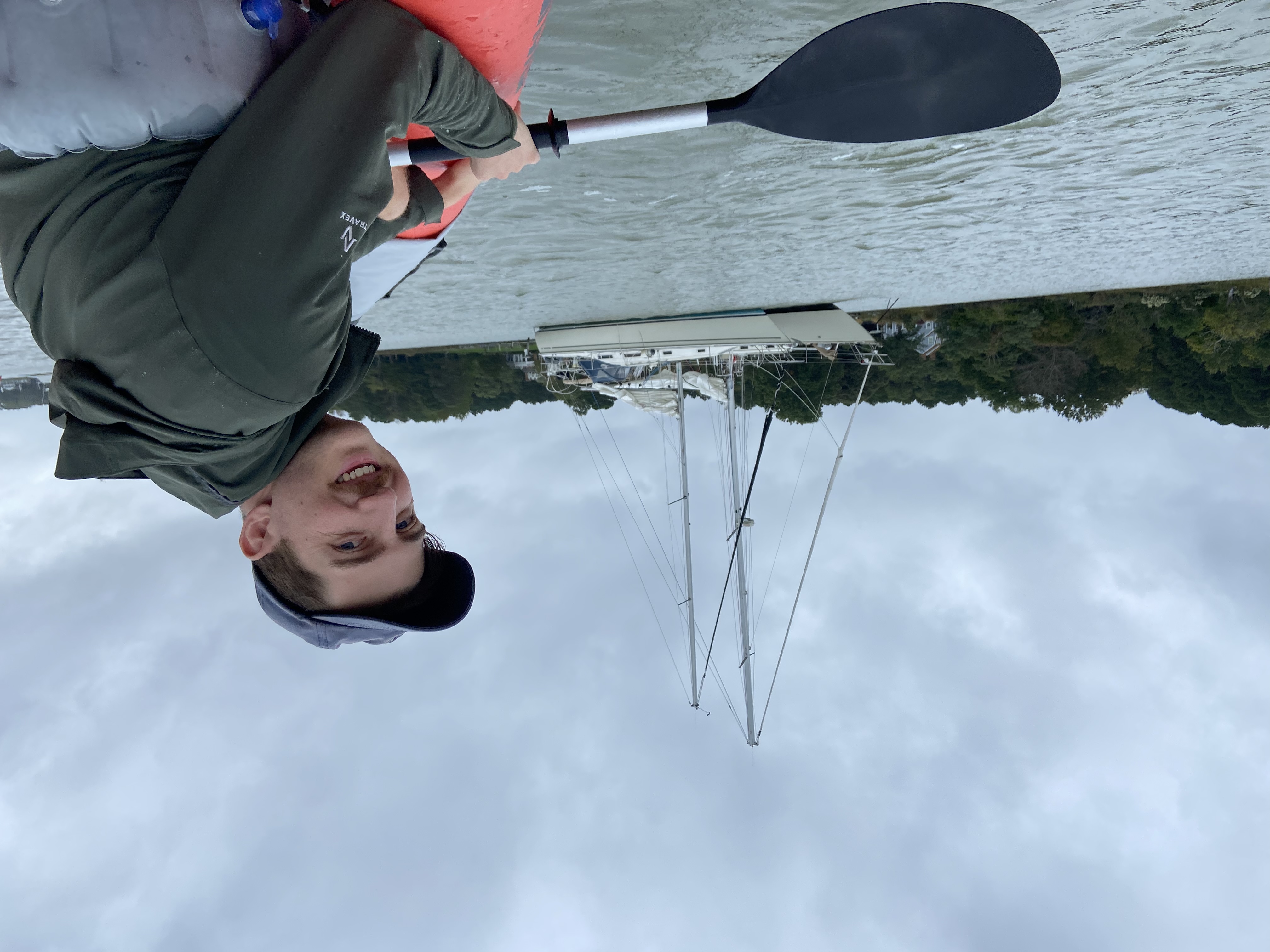
By 7:00 a.m. we’re back at the dinghy dock, tie up our inflatable tandem kayak, and walk into town. Our first mission is to caffeinate. I’m a recent inductee into the world of caffeine-dependence, and feel the twinge of a headache coming on, but Jacob belongs to the old guard of caffeine-addicts. He was the first person I ever knew to have enough points on the Starbucks loyalty app that the baristas would all curtsy in unison whenever he entered a franchise building. As we’re strolling past beautiful 18th century homes, brilliantly illuminated in the morning sun, I look over at Jacob to make an appreciative comment about the elegant curve of a colonial cornice on a nearby old building. I notice from his expression that my comment is stuck somewhere between the part of his brain that handles auditory processing and the part that is responsible for comprehension and response. I can hear gears grinding against one another inside of his head, bare metal on bare metal, dangerously lacking the critical lubrication of morning coffee.
Luckily, I’ve spent enough time in similar towns on the Eastern Shore of Maryland to know how to find a coffee shop. I begin scanning the streets for signs that feature the following formula: “The nautical adjective nautical fauna”. Within minutes, we stumble upon The Blue Crab, and dash in. (Had we gone another direction, we would still have been in luck, as there is apparently another coffee shop in St. Michaels called The Blue Heron.)
We are greeted by a familiar face. Apparently Jacob had indeed left a large enough tip the previous night, because the waitress from the Mexican restaurant, who seems to also work days as a barista at the coffee shop, recognizes us and welcomes us with a smile. After some much needed coffee and breakfast, we set out to explore the town.
Since I know most of you are here for the sailing action and would rather not read an inflated play-by-play of our mundane adventures in one of the Eastern Shore’s most commercialized tourist towns, I’ll be brief. I would just like to apologize to the Chesapeake Maritime Museum for allegedly “trespassing” and entering into their historic boat and lighthouse exhibit without paying the exorbitant entrance fee. We actually did not know that was a paid section of the museum until later, and anyway, if you don’t want people wandering in through the locked gates at the service access entrance, you shouldn’t leave the keys in the locks! Also, to all of the women in the café who conspired with us in hushed, desirous tones about where to find a fish sandwich at 10 a.m. on a Sunday, I am sorry to report that our quest was ultimately unsuccessful, but thank you for your generous help and support nonetheless.
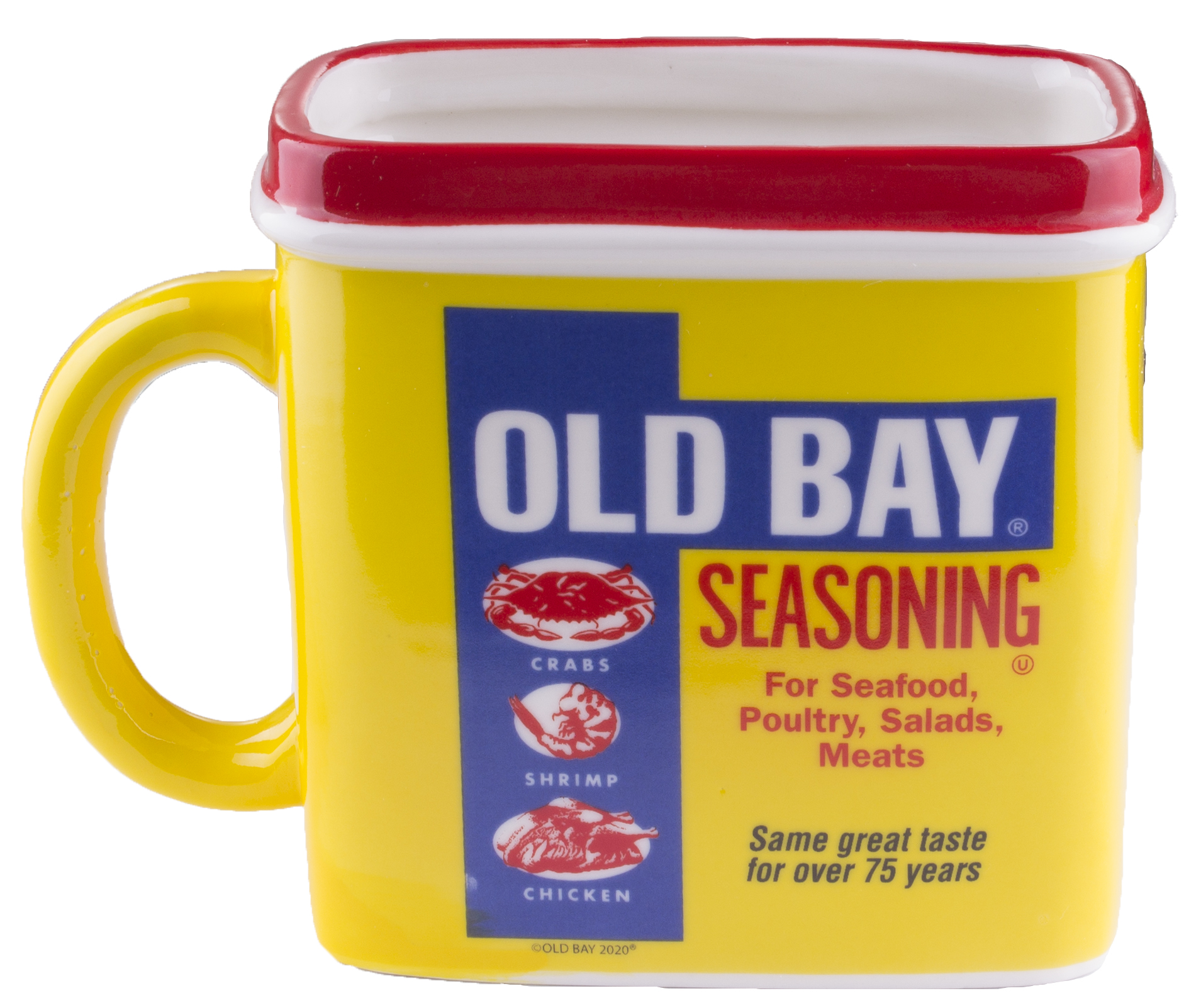
Around 11 a.m., Jacob declines the woman at the kitsch shop’s offer of a discount on a coffee mug made to look like the iconic rectangular container of a popular regional seafood spice, thanks her for letting him stroke her fluffy jacket, and we exit back onto the main thoroughfare of town, which at this point, is starting to become crowded with weekend vacationers. We decide that it’s time to head back to our boat and start the journey home and right when I’m about to call Chris to ask about the untethering procedure for our intertwined boats, we see our friends on the other side of the street, waiting in front of a creperie. We wave hello and cross the street to say our formal good-byes, thank-you-agains, and to point them in the direction of the free historic boat and lighthouse museum that we had discovered that morning.
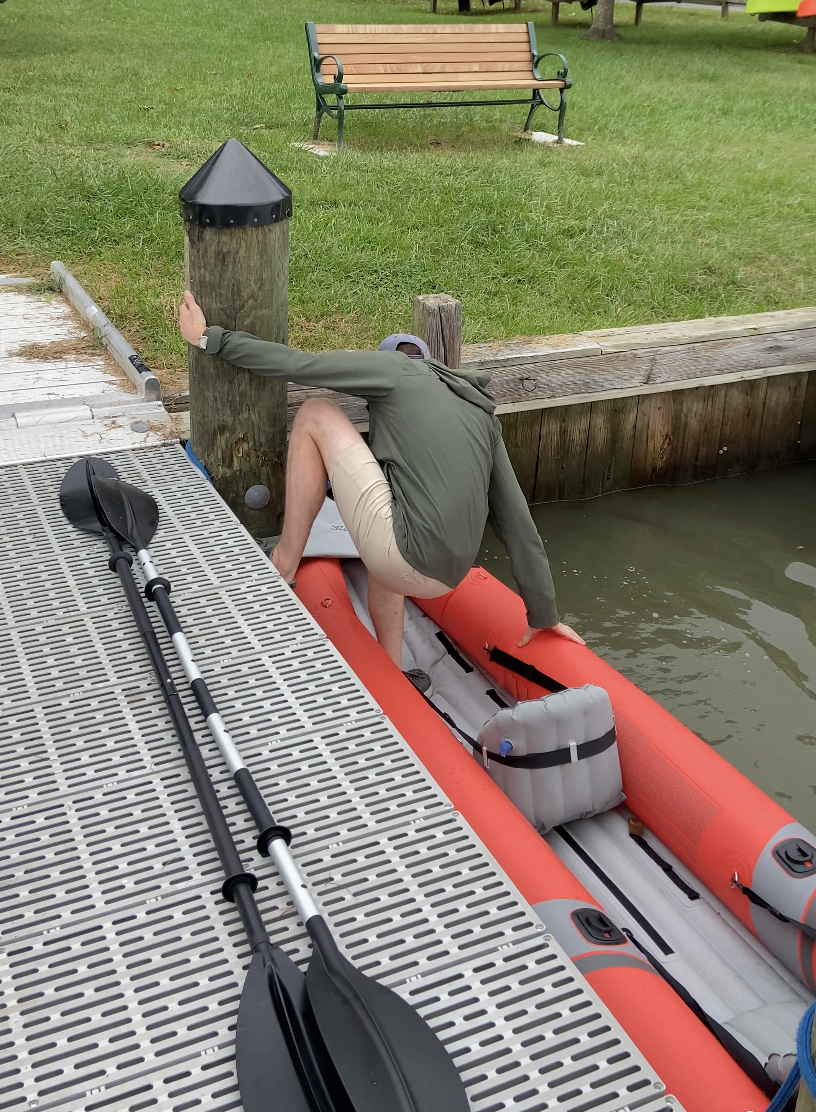
Ten minutes later, we carefully climb back into our kayak and begin to paddle back to our boat. As we approach the anchorage, I notice something that should have given me more pause than it did at the time. When a boat is at anchor, the wind still pushes the boat around, causing the bow to inevitably point in the direction that the wind is coming from. Because we were dealing with an easterly wind all weekend, the boats were pointing to the east when we had gone to sleep the night before and were still pointing east when we had left for town that morning. But as we return, the boats are resting at a slightly different orientation, pointing almost to the north. We are in a pretty protected anchorage with lots of weirdly shaped land around us, so I just chalk up the shift in direction to some weird wind shadow effect and don’t give it any more thought. Besides, we are starting to be in a hurry to leave. It’s already almost noon and we have at least five or six hours of sailing ahead of us today.
We stash the kayak, start the motor, check the sails, thank Chris’s boat’s anchor for holding us so steady all night, and cast off. Next stop, Knapps Narrows bridge!
Sunday Afternoon - Knapps Narrows Bridge
About fifteen minutes after leaving the anchorage, once I am assured that there are no real challenges or obstacles in our way for at least the next hour, I am overcome by a wave of exhaustion. I blame the stupidly loud automatic bilge pump that’s in my boat, which checks for water every 2.5 minutes and makes a sound that can really only be rendered in text as brrrrZZZZzzzrrr. The knowledgeable reader will understand. This last night was our first real night “on the hook,” and away from the convenience of 110 volt shorepower AC. This meant no fans. And no fans meant no white noise. In the sleepy atmosphere of the quiet anchorage, that regular motorized interruption of the bilge pump cut through the silence like a dull knife. I ask Jacob if he could take the helm for a few minutes while I go below deck and take a power nap. He graciously assents and I enjoy one of the best naps of my life.
When I awake, we are already halfway across the Choptank and on course to reach Knapps Narrows, the channel that cuts through Tilghman Island and will enable us to shave at least four or five nautical miles off the return journey. Jacob has already hoisted the sails and we are moving at a steady clip, despite the irregular wind, which now definitely seems to be coming from the north. Since the waters we are sailing in are bordered by land to the north, the wind is occasionally blocked and disturbed by various structures and land features. In other words, as we are leaving the Choptank, we are sailing more or less in a permanent “wind shadow.”
As we approach the narrows themselves, it occurs to me that we are going to have to radio the bridge operator to ask them to raise the bridge for us. This thought is simultaneously thrilling and anxiety-inducing. On the one hand, using the VHF radio on the boat is just so fun. You get to say things like “over” and “copy,” and people tend to refer to you as “captain” when they address you and your vessel. But on the other hand, it’s frightfully public. The transmitter is mounted on the top of the fifty foot mast, and when you broadcast something, you know that people are listening for miles and miles. This encourages a certain brevity, economy of word choice, and even demands a bit of rehearsal. I’ve never said anything on the radio that I didn’t already say to myself at least once under my breath, to make sure that I had it right, and could get it out without too many “uhhs” before pressing that button on the side of the handset and broadcasting my voice across the bay.
“Do you actually know what we are supposed to say to the Bridgetender?” I ask Jacob. I usually rely on Jacob for radio things, as he is a bit of a secret radio nerd. He has his amateur radio operator's license and whereas some people like to listen to music during work, Jacob sometimes entertains himself by tuning in to local emergency services frequencies and listening to their occupational chatter. In this case, however, Jacob is as clueless as I am. I assume that it’s not just as simple as saying “Please open the bridge, thank you,” so we do some creative Googling to get to the bottom of our problem. The first few articles that I find are barely of any help at all. They report on the channels typically used for bridge traffic and refer to the necessity to “make an opening request” for many unscheduled bridges, but none of them give us what we’re really looking for: the script. What are the actual words, the incantation, that we need to utter into the radio in order to get the bridge open, and to make sure that we don’t sound like total neophytes out here on the water? Eventually, I find an article in Sail magazine with the provocative title: “Confessions of a Bridgetender.”
The bridgetender interviewed in the article gives us exactly what we want. They outline exactly what the bridgetender wants and needs to hear from each vessel, how to best formulate it succinctly on the radio, and how to ensure a quick and friendly exchange. The interview subject takes very strong stances on the best practices for hailing a bridge. We take copious notes and begin formulating our message, repeating it back and forth to one another and rehearsing the proper voice to broadcast it with. And thank goodness we did our research! Neither of us even knew beforehand that you are supposed to repeat the name of the bridge that you are hailing at least three times before issuing any further instructions. Imagine how dumb we would have looked if we had only done it twice?
Finally confident in our planned broadcast, we approach the entrance to the narrows, fire up the motor, and drop the sails. There is a brief moment where I think that we should sail under the bridge, you know, for coolness points, but Jacob correctly points out that this is our first ever bridge crossing, and perhaps we should trade coolness for safety and maneuverability.
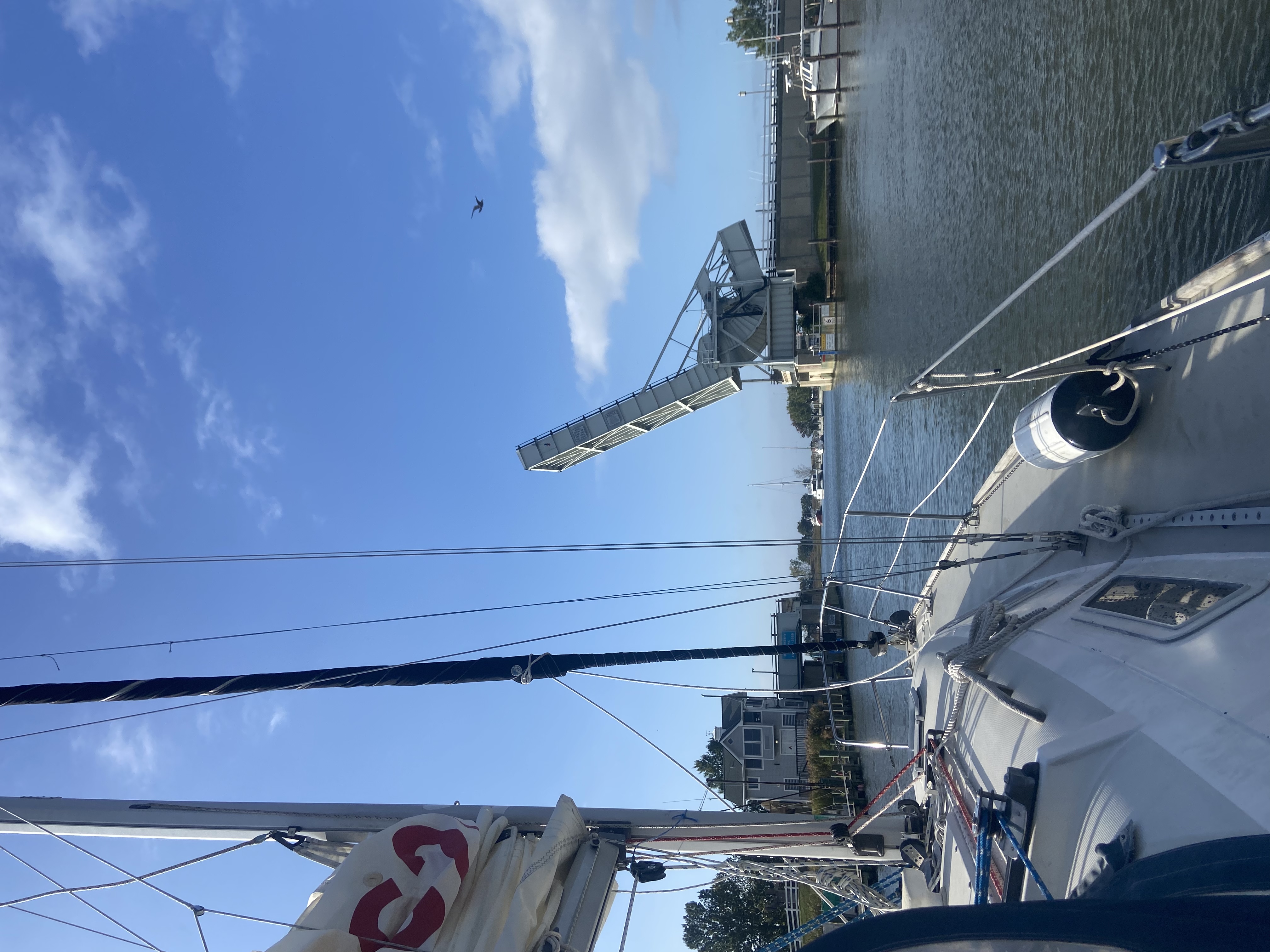
We motor up the channel, and once the bridge is in view, I hand Jacob the VHF handset and nod eagerly at him. “Just like we practiced.” Jacob takes the handset, swallows hard, clears his throat, and raises the receiver to his mouth. He takes one last deep breath, engages the button on the side of the handset, and sets in:
“Knapps Narrows Bridge, Knapps Narrows Bridge, Knapps Narrows Bridge. This is sailing vessel Liberty Call, hailing on channel one three. Do you read? Over.”
Jacob releases the talk button, I give him a deep nod of satisfaction, and we both look expectantly at the radio, awaiting the response. A few seconds pass. All we hear is the steady drone of the diesel engine beneath our feet and the light wind in our ears as we make progress along the channel, moving closer and closer to the bridge. Eventually, I pantomime to him that he should try again. I suppose I could just say this to him out loud, but using the radio is such a nerve-wracking experience that you just can’t be too careful. I am afraid to even use my voice, just in case the talk button is depressed and we are broadcasting. Jacob tries again:
“Knapps Narrows Bridge, Knapps Narrows Bridge, Knapps Narrows Bridge. This is sailing vessel Liberty Call. Do you read?”
Before we can even begin to anxiously await the reply, the handset crackles to life. We hear a gruff voice, disoriented, possibly recently roused from sleep:
“Yeah, what do you want?”
Thrown off by this unexpected informality, Jacob stumbles for a second, but then his practice and training kicks in, and he perfectly delivers our well-crafted message:
“Knapps Narrows Bridge, this is Liberty Call, a westbound sailing vessel, operating under motor power, hoping to transit the narrows from the Choptank to the Chesapeake. We are less than 10 minutes from the bridge and are requesting an opening. We have a total height of 49 feet above water and draw 3 feet 9 inches. Again, we are westbound and are requesting an immediate bridge opening. Sailing vessel Liberty Call. Over.”
The voice returns:
“Uhh… sure. I can’t even see you yet. Just come up to the bridge and I’ll open it.”
Clearly this bridgetender didn’t go to the same tending school as the one interviewed in the magazine article. But we do have to give him points for brevity.
As we approach the actual bridge, it slowly begins to open. It’s hard to describe the awesome sight and feeling of thousands of tons of metal slowly yawning open for your sole benefit. The thought of all of those cars needing to stop and wait for the bridge to open and close just so that we can pass underneath is exhilarating. Perhaps this amazement at the bridge sounds strange, but mundane and simple as it sounds, crossing under this bridge is one of my highlights of this entire weekend.
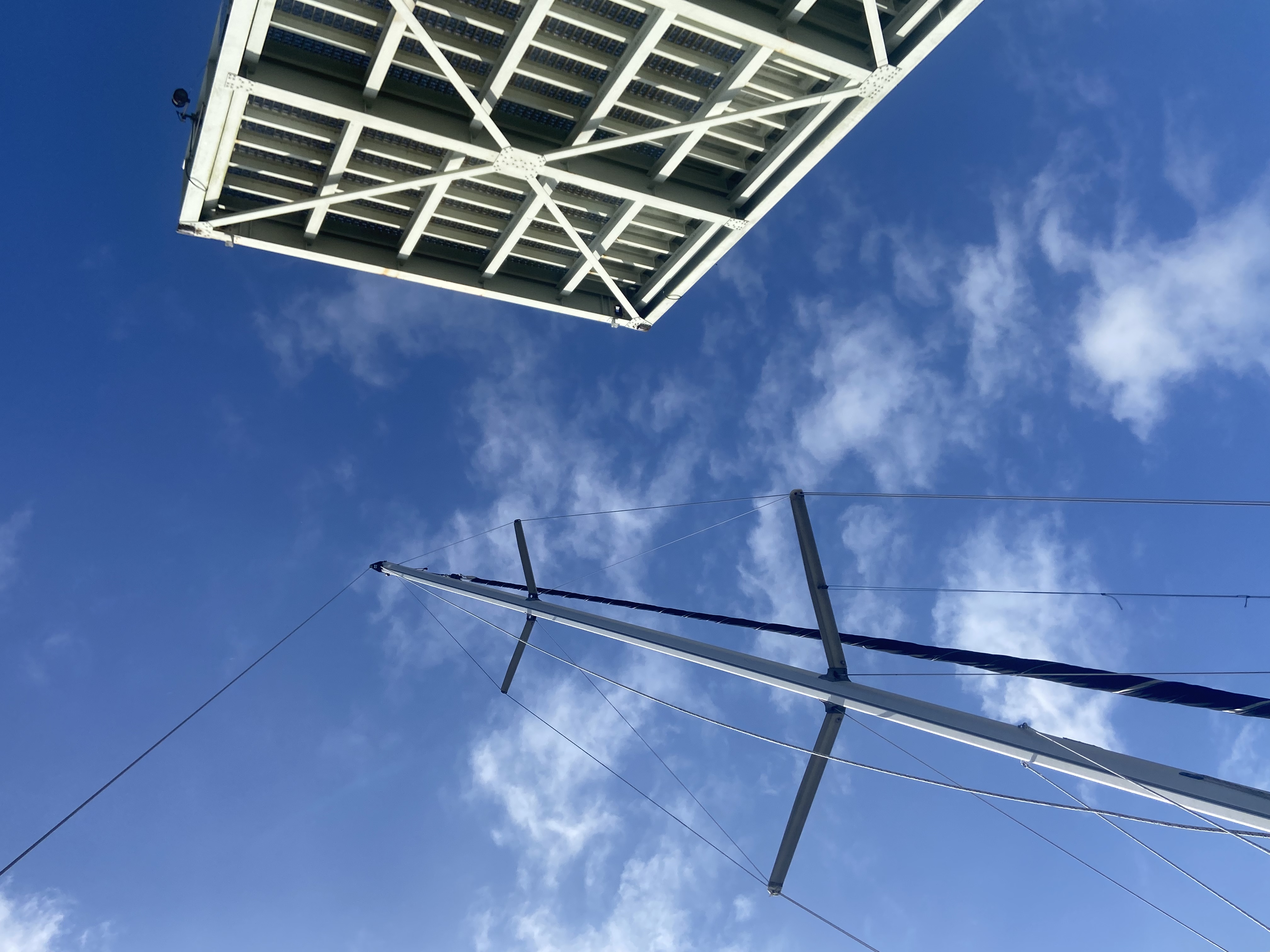
We slowly continue to motor up the channel and Jacob and I gaze agog at the massive steel structure directly above us as we pass underneath. It feels like all of our mistakes and faux pas of the weekend are absolved in this moment of successful navigation. It’s a simple feeling, but a powerful one.
As we emerge on the other side of the bridge, we are elated and giggling like school boys. I turn around to watch the bridge start to lower back down and look at the road to see how many cars we had inconvenienced. To my immense disappointment, there are exactly zero cars waiting on either side of the bridge. “What’s the point of having them open the bridge if we aren’t going to inconvenience a single motorist?” I ask Jacob, shaking my head in dissatisfaction.
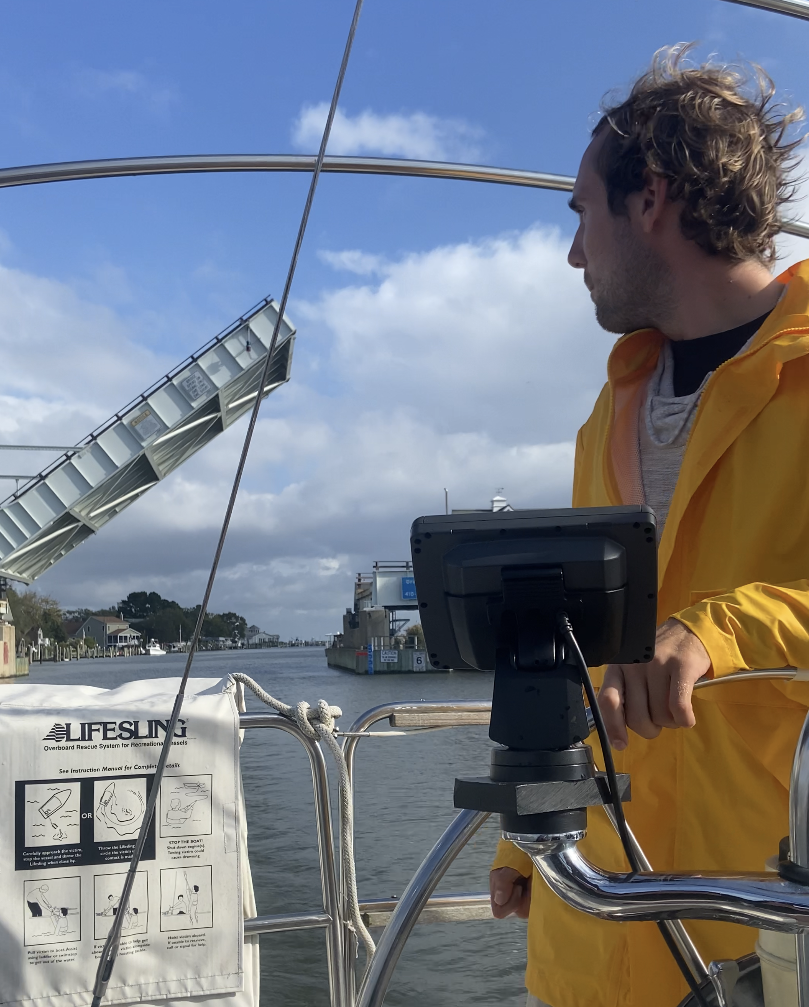
Sunday Afternoon - Crossing the bay
The bridge disappears behind us as we motor back out onto the Chesapeake. The wind is blowing 18 knots steady out of the north, gusting up to 25+ knots. Until now, we’ve been in somewhat of a wind shadow; the land to the north of us has shielded us from the worst of the wind conditions. But now that we are back in the open water, we feel the full brunt of it—and it’s pretty intense. We both take a proactive Dramamine pill, tighten our life jackets, and mentally prepare for the ride home.
The wind is so strong that we hoist the main sail with the second reef already in and then unfurl just a scrap of head sail, more to balance the boat than anything else. Despite the minuscule amount of sail, we are easily doing five knots of boat speed right out of the gate. The wind is coming directly out of the north and we are basically wanting to cut directly west across the bay, so choosing a point of sail isn’t difficult—we try for a beam reach. The main difficulty proves to be in managing the waves.
We’re only on the Chesapeake, not in the middle of the ocean, so it’s not like the waves are “The Perfect Storm” big. Like any aspiring sailor, I’m prone to exaggeration and sea stories, but I’ll spare you the delusion of twenty foot waves throwing our boat around. But the waves are big enough to be uncomfortable, and even a little dangerous. It’s not raining, but Jacob and I put the hoods of our raincoats up because every few minutes we catch a wave on the bow or beam that splashes over the boat and drenches the cockpit. This is a mere inconvenience, however. The real issue is trying to control the boat while taking waves on the beam. The crashing waves push the boat off course, the sails flap around, and you lose power and threaten to stall out. In order to deal with the conditions, you need to strategically steer around the waves, knowing just when to cut into them and how to fall back off. Luckily I had recently had a lot of experience with this kind of defensive steering while sailing on the North Sea in a much bigger boat (and with much bigger waves), so I feel confident and capable as Jacob and I press forward and begin crossing the bay.

These are definitely the stiffest conditions that I’ve sailed my own boat in. There’s a small craft advisory on the radio, and we briefly discuss turning back. But where would we dock the boat? How would we get Jacob to the airport in D.C. the next morning? The weather looks like it won’t lighten up for at least another day. What work meetings does he have? Does he have his work laptop on board with him? Could he move his flight?
In the end, we acknowledge that we’ve already committed one of the cardinal sins of sailing—sailing on a schedule—and need to push forward. We’re both a little nervous as we leave the land behind us and head out into the middle of the bay. I have an iron-tight grip on the wheel and am doing my best to keep us from getting overpowered by the wind or waves. Jacob is doing his best to appear calm and collected, but I notice him quietly taking stock of all our safety gear and positioning things to be in favorable positions should anything go awry. This makes me feel better, too, and I focus all of my attention on the task at hand.
Hours pass, and we make swift, steady progress across the bay. We’re wet and it’s exhausting trying to balance ourselves at such an extreme heel. Jacob and I don’t say much else to one another other than the occasional “How are you doing?” or “Are we on course?” We are both just holding fast, reacting to slight changes in the weather as needed, and thinking about how good a post-voyage beer might taste. In the five hours it takes us to cross the bay, we see a grand total of one other boat of any kind at all. It’s a fishing boat, and despite the fact that we must be the only two vessels crazy enough to be on the bay in these conditions, Jacob and I are forced to briefly change course at one point to avoid hitting them. There must be some kind of law of gravitational attraction at play on the water that I’m not aware of.
Eventually, however, we make it back to our little protected harbor, drop the sails, motor up the channel and dock the boat. Docking is always a difficult endeavor, especially in strong winds, but after this exhausting crossing, I’m too tired to even be anxious. We tie up the boat, hug each other, and collapse on the couch in the disheveled cabin for a few minutes of rest. The sun sets and our stomachs are grumbling, so, eventually, we rouse ourselves, search for our keys and wallets, step off the boat, and, feeling a kind of satisfied pride in our weekend’s adventure, set off on land to find that beer.

